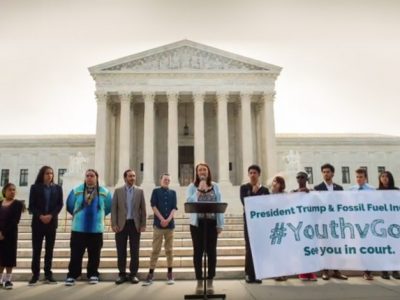 For many aspiring environmental litigators, such as ourselves, the bold Juliana litigation was the little-case-that-could: it presented a novel constitutional theory to redress the climate crisis, survived a motion to dismiss against all odds, and went up to the Supreme Court not once, but twice. But on January 17, 2020, Juliana hit a significant roadblock …
For many aspiring environmental litigators, such as ourselves, the bold Juliana litigation was the little-case-that-could: it presented a novel constitutional theory to redress the climate crisis, survived a motion to dismiss against all odds, and went up to the Supreme Court not once, but twice. But on January 17, 2020, Juliana hit a significant roadblock …
The post Guest Contributors Rosa Hayes and Samantha Peltz: Silver Linings in the 9th Circuit’s Juliana Decision appeared first on Legal Planet.
#theclimatecrisis #thesupremecourt
For many aspiring environmental litigators, such as ourselves, the bold Juliana litigation was the little-case-that-could: it presented a novel constitutional theory to redress the climate crisis, survived a motion to dismiss against all odds, and went up to the Supreme Court not once, but twice. But on January 17, 2020, Juliana hit a significant roadblock in the Ninth Circuit. As others have written on this blog, the majority of a three-judge panel ruled that the youth plaintiffs lacked standing to continue litigating their claims because their requested remedy could not be redressed by an Article III court.
Although the majority’s opinion left furrowed brows on both sides of the debate, three aspects of the Ninth Circuit opinion may nevertheless help to establish standing in future climate litigation in the Ninth and other circuits. First, the Ninth Circuit’s discussion and acceptance of the scientific evidence regarding the consequences and causes of anthropogenic climate change will make it easier for future litigants to satisfy the first and second prongs of the standing inquiry: injury-in-fact that is causally linked to government (in)action. Second, the Juliana court’s holding on the causation of climate change harms will make it easier for future climate change litigants to satisfy the second, causation prong of the standing inquiry. Third and finally, the Ninth Circuit declined to find that the claims in Juliana presented nonjusticiable political questions, lowering the separation of powers bar to adjudicating constitutional climate questions from a wholesale bar to a remedy-dependent threshold.
Injury-in-fact
The Juliana court refused to overturn the district court’s ruling on the existence of a right to a livable climate, a holding that will undoubtedly prove beneficial to future climate litigants. Specifically, the court’s reliance on expert testimony introduced into the record will provide a passim citation in future litigation. This record will make it easier for plaintiffs in climate litigation to satisfy the first prong of the standing inquiry, injury-in-fact.
In particular, the opinion leaves little basis for denying that climate change is occurring at an increasingly rapid pace or that anthropogenic emissions have caused the climate crisis. Copious evidence introduced into the record establishes that the past two centuries’ unprecedented rise in atmospheric carbon dioxide derives from fossil fuel production and emissions and that this atmospheric change will wreak havoc on our climate, left unchecked. The Juliana court further acknowledged that society is approaching a tipping point, after which we may not be able to undo certain consequences of climate change. Most fundamentally, the court acknowledged that the federal government has been aware of the risks of fossil fuel combustion and greenhouse gas emission as early as 1965.
Causation
The Juliana court created new precedent that recognized the causal link between government inaction and the plaintiffs’ environmental and climate harms. Previously, establishing causation arising from government inaction had posed a significant hurdle to demonstrating standing in climate and environmental law cases, due in part to both the complexities and layers of alleged causation, and the timespan in which such actions have occurred.
The opinion also distinguishes two key precedents that have long posed an obstacle to environmental and climate plaintiffs attempting to establish a causal link between behavior and its effects. In Washington Environmental Council v. Bellon, the Ninth Circuit determined that the alleged causal nexus—between municipal agencies’ failure to define emissions limits for greenhouse gases for five oil refineries and the alleged adverse environmental effects of global climate change—was too attenuated for the plaintiffs to establish standing. The Juliana court differentiated the youth plaintiffs’ allegations regarding government inaction by observing that the breadth and scope of the challenged actions indicated “at least a genuine factual dispute as to whether those policies were a ‘substantial factor’ in causing the plaintiffs’ injuries.”
The Juliana decision also indirectly resolved a causation problem created by dicta in Judge Pro’s concurrence in Native Village of Kivalina v. Exxon Mobil Corp., which some district courts in the Ninth Circuit have cited for the proposition that the “line of causation” between the defendant’s action and the plaintiff’s harm must be “more than attenuated.” By holding that causation can be established even where the challenged activity spans “over 50 years” or is not the sole cause of the injury alleged, the Ninth Circuit appropriately relegated those musings to dicta.
The following language used in the court’s causal analysis should enable plaintiffs in future climate lawsuits to demonstrate a causal link between government (in)action and concrete injuries from emissions as long as their complaint identifies a sufficient number of responsible policies across an appropriate timespan:
Causation can be established even if there are multiple links in the chain as long as the chain is not hypothetical or tenuous. The causal chain here is sufficiently established. The plaintiffs’ alleged injuries are caused by carbon emissions from fossil fuel production, extraction, and transportation. . . .the plaintiffs’ evidence shows that federal subsidies and leases have increased those emissions. (Internal citations and quotation marks omitted.)
Political Question Doctrine
Third and finally, Juliana’s nonredressability holding is unfortunate, but at least avoids something substantially worse. The Juliana majority chose the weaker of two separation-of-powers obstacles—redressability and not the political question doctrine—on which to dismiss the plaintiffs’ claims. A finding of nonjusticiability due to the presence of a political question would have entirely precluded future adjudication of constitutional climate change claims in the Ninth Circuit. Although the Juliana majority spent pages discussing political question doctrine cases and cited those cases in support of its redressability holding—over the dissent’s objections—by dismissing on nonredressability, the Ninth Circuit has at least left the door open for future litigation on this issue.
In short, Juliana leaves a glass partially full. If shrewd climate litigators prudently build on the Ninth Circuit’s holdings on injury in fact and causation, Juliana can be a win en route to the merits in other, future cases.
Rosa Hayes and Samantha Peltz are both aspiring environmental litigators and third-year law students in Yale Law School’s Peter Gruber Rule of Law Clinic. They enjoy spending time in the outdoors with their respective dogs.
The post Guest Contributors Rosa Hayes and Samantha Peltz: Silver Linings in the 9th Circuit’s Juliana Decision appeared first on Legal Planet.
By: Guest Contributor
Title: Guest Contributors Rosa Hayes and Samantha Peltz: Silver Linings in the 9th Circuit’s Juliana Decision
Sourced From: legal-planet.org/2020/05/11/guest-contributors-rosa-hayes-samantha-peltz-silver-linings-in-9th-circuit-juliana-litigation/
Published Date: Mon, 11 May 2020 17:40:11 +0000
Vist Maida on Social Me
Website Links
Maida Law Firm - Auto Accident Attorneys of Houston, by fuseology

No comments:
Post a Comment